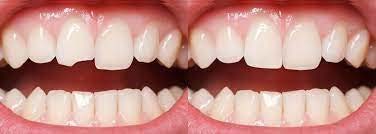What is Dental Bonding?
Dental bonding can be used to fix broken, cracked or discolored teeth without the need for a crown or veneer. Dental bonding is a simple, safe and conservative alternative to fix chipped, cracked, broken or discolored teeth.
How does it work? A dentist first removes any decay or defects on the tooth in question. A tooth colored resin is then applied over the tooth and bonded to the tooth using a blue light. This returns the tooth to a healthy and stable condition, while giving the tooth a natural appearance.
This also fixes any defects of the teeth that may have been present. Bonded restorations are appropriate for teeth with chipped edges, small cracks, small to moderate sized cavities, and discoloration.

The Benefits
One of the biggest benefits about dental bonding is that it often requires minimal prep of the teeth. That is, it does not require as much drilling as other alternatives. Thus, more of your natural tooth is preserved. Treatment typically takes less time than a crown or veneer. As a result, bonding is a great option for patients who want a simpler and more cost effective fix.
The composite resin that is bonded to the teeth comes in a large variety of tooth colors, allowing for a custom shade match to every individual’s teeth. This makes it possible to use bonding to alter the color of teeth. By applying the resin and bonding over discolored areas the shade of a tooth can be altered to match a patient’s preference.
Additionally, the dentist shapes the bonded resin to your teeth by hand, allowing for the restoration to match the shape and size of every tooth. So, if a tooth is chipped or cracked, the dentist custom designs and places the bonded restoration to replicate the tooth structure which was lost.
Front Teeth Restorations
Bonding is used in esthetic restorations of the front teeth. It is also done in any areas where decay is present, front or back. Meaning this type of restoration can be used to fix both chipped or cracked teeth, as well as filling cavities. When done on front teeth, removing and filling decay can often provide immediate improvement to the appearance of one’s teeth and smile.
Bonding is a good alternative to crowns or veneers in areas where smaller defects are present. Additionally, bonding is usually a more cost friendly option than a veneer or crown. However, dental bonding is not suited for larger restorations. In these cases, veneers or crowns are the preferred treatment as it gives the tooth a better prognosis for long term survival.
Considerations after Dental Bonding
Patients should know that while bonding is a simpler procedure and typically does not require as much drilling, it is possible for the restorations to break if they are not cared for properly. It is not advised to bite into hard foods with a front tooth that has been bonded. Biting into something hard like an uncooked carrot or hard candy can easily fracture a bonded restoration. Instead, it is recommended to cut up food, and chew with your back teeth.
Additionally, just like any other restoration placed in your mouth, it is vitally important to keep them clean. Cavities can form around or under a bonded restoration, and this may cause the restoration to fail. This necessitates a replacement restoration which can often be avoided by good oral hygiene.
Dental bonding is a great option for a simple way to improve the appearance of your smile. While it may not be the best option for every case, when used appropriately patients are typically very pleased with the result.





